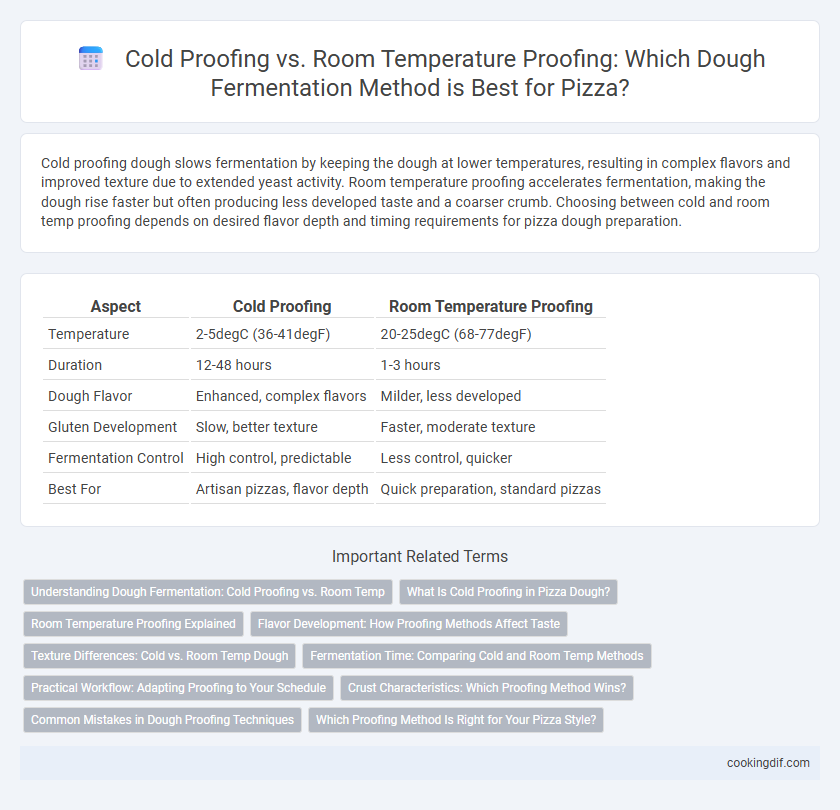Cold proofing dough slows fermentation by keeping the dough at lower temperatures, resulting in complex flavors and improved texture due to extended yeast activity. Room temperature proofing accelerates fermentation, making the dough rise faster but often producing less developed taste and a coarser crumb. Choosing between cold and room temp proofing depends on desired flavor depth and timing requirements for pizza dough preparation.
Table of Comparison
| Aspect | Cold Proofing | Room Temperature Proofing |
|---|---|---|
| Temperature | 2-5degC (36-41degF) | 20-25degC (68-77degF) |
| Duration | 12-48 hours | 1-3 hours |
| Dough Flavor | Enhanced, complex flavors | Milder, less developed |
| Gluten Development | Slow, better texture | Faster, moderate texture |
| Fermentation Control | High control, predictable | Less control, quicker |
| Best For | Artisan pizzas, flavor depth | Quick preparation, standard pizzas |
Understanding Dough Fermentation: Cold Proofing vs. Room Temp
Cold proofing pizza dough slows fermentation by keeping it at temperatures between 38degF and 45degF, enhancing flavor complexity through extended yeast activity and gluten development over 12 to 72 hours. Room temperature proofing, typically at 70degF to 75degF, accelerates fermentation, producing dough ready in 1 to 3 hours but with less pronounced flavor and airy texture. Choosing cold proofing results in a chewier, more flavorful crust, while room temperature proofing offers quicker preparation suitable for immediate baking.
What Is Cold Proofing in Pizza Dough?
Cold proofing in pizza dough refers to the process where the dough ferments slowly in a refrigerated environment, typically between 34degF to 40degF (1degC to 4degC) for 12 to 72 hours. This technique enhances flavor complexity by allowing yeast and enzymes to develop more nuanced organic acids and aroma compounds during the extended fermentation period. Cold proofing also improves dough texture, resulting in a chewier crust with better oven spring and more uniform gas retention compared to room temperature proofing.
Room Temperature Proofing Explained
Room temperature proofing allows pizza dough to ferment at around 70degF to 75degF, accelerating yeast activity for faster rising within 1 to 2 hours. This method enhances dough elasticity and flavor development by maintaining optimal hydration and temperature. Room temperature proofing is ideal for immediate use, creating a soft, airy crust with balanced yeast fermentation profiles.
Flavor Development: How Proofing Methods Affect Taste
Cold proofing dough at low temperatures slows fermentation, allowing enzymes and yeast to develop more complex, nuanced flavors through prolonged sugar breakdown and gas production. Room temperature proofing accelerates fermentation, resulting in a quicker rise but a more straightforward, less intricate taste profile due to faster yeast activity. The extended cold fermentation enhances acidity and aromatic compounds, contributing to a richer, more distinctive pizza crust flavor compared to the milder taste from room temperature proofed dough.
Texture Differences: Cold vs. Room Temp Dough
Cold proofing dough develops a more complex flavor profile and yields a chewier, airier crust with larger, irregular holes due to slower yeast activity. Room temperature proofing produces faster fermentation, resulting in a softer, more uniform crumb with a slightly denser texture. The extended cold fermentation enhances gluten development, creating a crispier exterior once baked.
Fermentation Time: Comparing Cold and Room Temp Methods
Cold proofing dough slows fermentation by maintaining temperatures between 38degF and 50degF, extending the fermentation time from 12 to 72 hours, which develops more complex flavors. Room temperature proofing occurs between 70degF and 80degF, typically completing fermentation in 1 to 3 hours, resulting in faster yeast activity but less depth in taste. Longer cold fermentation enhances gluten strength and dough texture, while shorter room temperature proofing prioritizes quick preparation over flavor development.
Practical Workflow: Adapting Proofing to Your Schedule
Cold proofing pizza dough slows fermentation by storing the dough in the refrigerator at around 4degC (39degF), allowing flavor development over 24 to 72 hours, which suits flexible, long-term scheduling and enhances dough complexity. Room temperature proofing accelerates fermentation by keeping the dough between 21degC to 27degC (70degF to 80degF), making it ideal for faster workflows with proofing times ranging from 1 to 3 hours to achieve adequate rise. Adjusting proofing methods based on time availability and desired dough characteristics helps pizzerias and home bakers optimize texture, flavor, and production timing efficiently.
Crust Characteristics: Which Proofing Method Wins?
Cold proofing dough at low temperatures enhances gluten development and slows fermentation, resulting in a chewier crust with complex flavor profiles and a crisp exterior. Room temperature proofing accelerates yeast activity, producing a softer crust with a more uniform crumb and lighter texture. For a balanced crust combining chewiness and crispness, cold proofing is often preferred by pizza artisans aiming for optimal fermentation control.
Common Mistakes in Dough Proofing Techniques
Cold proofing pizza dough slows fermentation by maintaining temperatures around 4degC (39degF), which enhances flavor and texture but requires extended time and careful temperature control to avoid over-proofing or under-proofing. Room temperature proofing accelerates fermentation at approximately 21-24degC (70-75degF), risking uneven proofing and over-activity if not monitored closely, often resulting in dough with poor structure and inferior rise. A common mistake is failing to adjust proofing time for temperature differences, leading to inconsistent dough elasticity and flavor development critical for optimal pizza crust.
Which Proofing Method Is Right for Your Pizza Style?
Cold proofing extends fermentation up to 48 hours at 38degF, developing complex flavors and a chewier texture ideal for Neapolitan and artisan-style pizzas. Room temperature proofing accelerates yeast activity within 1-2 hours at 70degF, producing a softer crust suited for thin-crust and New York-style pizzas. Selecting the proofing method depends on desired crust characteristics and timing constraints, with cold proofing favored for depth of flavor and room temperature for quick preparation.
Cold proofing vs Room temp proofing for dough fermentation Infographic

 cookingdif.com
cookingdif.com